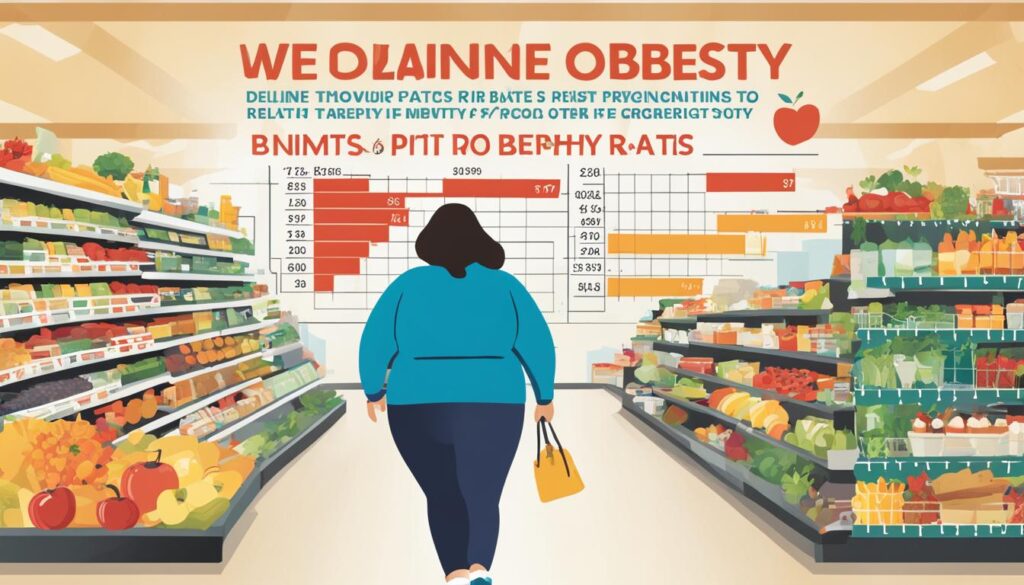Obesity prevention programs have a clear goal – to reduce the risk factors associated with obesity and promote healthier lifestyles. The importance of establishing concrete goals in these programs cannot be overstated. By setting specific objectives, we can assess the effectiveness of interventions and measure the impact of our efforts.
In order to combat the growing epidemic of obesity, it is crucial to have well-defined goals that guide our actions and inspire positive change. These goals encompass various aspects, from individual behavior modification to community-wide initiatives.
The primary objective of obesity prevention programs is to prevent the onset of obesity and its associated health conditions. By focusing on early intervention and education, we can empower individuals to make informed choices about their diet, physical activity, and overall well-being.
Additionally, these programs aim to create supportive environments that foster healthier behaviors. By addressing socioeconomic factors, such as access to nutritious food and safe physical activity spaces, we can promote equity and ensure that everyone has the opportunity to live a healthy life.
Ultimately, the goal of obesity prevention programs is to improve the health and well-being of individuals and communities. By working together and staying committed to these goals, we can make significant strides in the fight against obesity.
Key Takeaways:
- Obesity prevention programs have clear goals to reduce the risk factors associated with obesity and promote healthier lifestyles.
- Goals in these programs enable us to assess the effectiveness of interventions and measure the impact of our efforts.
- The primary objective is to prevent the onset of obesity and its associated health conditions.
- Early intervention, education, and creating supportive environments are essential in achieving these goals.
- By working together and staying committed to these goals, we can make significant strides in the fight against obesity.
The Impact of the Let’s Move Campaign
The Let’s Move campaign, launched by First Lady Michelle Obama in 2010, has had a significant impact in the fight against childhood obesity. This nationwide initiative aims to empower parents and consumers to make healthier choices for themselves and their families.
The Let’s Move campaign takes a comprehensive approach to address the complex issue of childhood obesity. By focusing on key areas such as nutritional labeling, school lunch programs, physical activity opportunities, and access to healthy foods, the campaign aims to create lasting changes in eating, nutrition, and physical activity behaviors.
The Let’s Move campaign has been instrumental in raising awareness about the importance of combating childhood obesity. Through its efforts, the campaign has helped to highlight the urgency of the issue and mobilize communities to take action.
Revamping Nutritional Labeling
One of the key strategies of the Let’s Move campaign is to revamp nutritional labeling. By making nutritional information more accessible and easier to understand, consumers can make informed choices about the foods they consume. This empowers individuals to make healthier choices for themselves and their families.
Improving School Lunch Programs
The Let’s Move campaign recognizes the importance of providing nutritious meals to children during school hours. By working to improve school lunch programs, the campaign aims to ensure that children have access to healthy and balanced meals that support their overall health and well-being.
Increasing Physical Activity Opportunities
Physical activity is a critical component of a healthy lifestyle. The Let’s Move campaign seeks to increase physical activity opportunities for children both in and out of school. By promoting physical education, recess, and other activities, the campaign aims to instill lifelong habits of regular physical activity.
Improving Access to Healthy Foods
The availability of healthy foods in all communities is essential for combating childhood obesity. The Let’s Move campaign works to improve access to fresh and affordable produce, as well as other nutritious options, in underserved areas known as food deserts. By addressing this disparity, the campaign aims to ensure that all families have access to the foods they need to maintain a healthy lifestyle.
The Let’s Move campaign has made significant strides in the fight against childhood obesity. Through its efforts, the campaign has raised awareness, promoted healthier choices, and influenced policies to create a healthier environment for children and families. By addressing the complex factors contributing to childhood obesity and implementing anti-obesity strategies, the Let’s Move campaign has played a crucial role in improving the health and well-being of future generations.
Early Intervention for Obesity Prevention

Early intervention plays a crucial role in the prevention of childhood obesity. Research has shown that addressing key risk factors during pregnancy and infancy can have a significant impact on reducing the risk of obesity later in life. Factors such as excessive maternal weight gain, smoking during pregnancy, shorter duration of breastfeeding, and suboptimal sleep during infancy have been identified as contributors to childhood obesity.
By implementing targeted interventions that address these risk factors, we can effectively prevent weight gain and mitigate the long-term consequences of childhood obesity. These interventions may include education and support for expectant mothers, promoting healthy lifestyle behaviors during pregnancy, and providing early nutrition guidance.
“Early intervention is a critical component of obesity prevention. By addressing risk factors during pregnancy and infancy, we have the opportunity to establish healthy habits and prevent the onset of obesity.” – Dr. Emily Johnson, Pediatrician
Through comprehensive early intervention strategies, we can empower parents, caregivers, and healthcare professionals to make informed choices that support healthy development and prevent childhood obesity. By addressing these risk factors during early stages of life, we can create a solid foundation for lifelong health and wellness.
Promoting Early Intervention
When it comes to early intervention for obesity prevention, collaboration between healthcare providers, community organizations, and policymakers is crucial. The collective efforts of these stakeholders can help develop and implement effective strategies that promote healthy behaviors from the earliest stages of life.
Some key initiatives and interventions for promoting early intervention include:
- Providing prenatal education and support to expectant mothers on healthy nutrition and lifestyle choices
- Offering breastfeeding support and education to promote optimal nutrition for infants
- Creating accessible and affordable opportunities for physical activity for children and families
- Implementing nutrition education programs in early childhood settings
- Collaborating with community organizations to establish supportive environments for healthy living
By prioritizing early intervention and implementing evidence-based strategies, we can effectively combat the childhood obesity crisis and equip children with the tools they need for a healthy future.
Summary
Early intervention is a key component of obesity prevention, particularly in addressing risk factors during pregnancy and infancy. By targeting factors such as excessive maternal weight gain, smoking during pregnancy, shorter duration of breastfeeding, and suboptimal sleep during infancy, we can significantly reduce the risk of childhood obesity. Collaborative efforts among healthcare providers, community organizations, and policymakers are essential to promoting early intervention and creating a supportive environment for healthy living from an early age.
The Role of Diet and Nutrition in Obesity Prevention
Nutrition interventions play a crucial role in obesity prevention. By providing education and support for parents and caregivers, we can empower them to make healthier food choices for themselves and their families. These choices should be based on dietary guidelines that promote balanced nutrition and overall health.
Improving the nutritional quality of school meals and other foods sold in educational settings is another key strategy in obesity prevention. By offering nutritious options and reducing the availability of unhealthy foods, we can promote healthier eating behaviors among children and adolescents.
One effective way to achieve this is by implementing nutrition education programs. These programs should aim to teach individuals the importance of a balanced diet and how to make informed food choices. By promoting knowledge about nutrition from an early age, we can instill healthy habits that will last a lifetime.
In summary, diet and nutrition play a fundamental role in obesity prevention. Through nutrition interventions, education, and the promotion of dietary guidelines, we can empower individuals to make healthy food choices. By improving the nutritional quality of foods in schools and implementing nutrition education programs, we can create an environment that supports healthy eating behaviors.
| Key Recommendations | Beneficial Foods | Limitations |
|---|---|---|
| Consume a variety of fruits and vegetables | Fresh fruits, leafy greens | Processed fruits, fruit juices |
| Choose whole grains | Whole wheat bread, brown rice | Refined grains, white bread |
| Include lean protein sources | Skinless poultry, legumes | Fatty cuts of meat, processed meats |
| Reduce added sugars | Natural sweeteners in moderation | Sugary beverages, desserts |
| Limit sodium intake | Herbs, spices for flavoring | Salty snacks, processed foods |
| Avoid trans fats | Healthy oils, nuts | Fried foods, processed snacks |
“The decisions you make about what you eat and drink matter. They determine whether you set yourself up for sickness or health.”
– Dr. David L. Katz
Physical Activity and Obesity Prevention

To effectively prevent obesity, it is vital to prioritize physical activity in our daily lives. Regular physical activity not only helps individuals maintain a healthy weight but also reduces the risk of chronic diseases associated with obesity. By promoting an active lifestyle, we can make significant progress in combating this epidemic.
A key area where physical activity can be encouraged is in schools. Quality physical education classes, recess breaks, and extracurricular activities that emphasize movement and play are critical for instilling healthy habits in children. These opportunities not only promote physical fitness but also improve cognitive function and social interaction.
Creating a safe and accessible environment for children to engage in physical activity is essential. Safe parks, playgrounds, and recreational facilities provide opportunities for children to be active outside of school hours. By ensuring access to these spaces, we can encourage children to engage in physical activities that they enjoy, making it more likely that they will develop a lifelong habit of staying active.
Encouraging Physical Activity:
- Promote physical activity in schools through collaborative efforts with educators, parents, and community organizations.
- Create structured physical activity programs that cater to different interests and abilities.
- Provide resources and support for extracurricular sports, clubs, and organizations that promote active lifestyles.
- Integrate physical activity into daily routines, such as walking or biking to school or work.
- Encourage families to engage in physical activities together, such as hiking, biking, or playing sports.
In conclusion, increasing physical activity levels is crucial in the fight against obesity. By prioritizing physical activity in schools and communities, we can promote an active lifestyle and help prevent obesity-related health issues. By providing safe and accessible environments for physical activity and encouraging individuals to be active on a daily basis, we can create a healthier future for generations to come.
Addressing Socioeconomic Factors in Obesity Prevention

Socioeconomic factors play a significant role in the prevention of obesity. One important aspect to address is the presence of food deserts, which are areas with limited access to affordable and nutritious food. These areas often lack grocery stores and other sources of healthy food options, making it difficult for residents to maintain a balanced diet.
To combat this issue, it is crucial to implement strategies that improve access to healthy food in underserved areas. This can be achieved by lowering the relative prices of healthier foods, making them more affordable for individuals and families with lower incomes. Additionally, efforts should be made to promote the development of healthy food retailers in these areas, ensuring residents have convenient and reliable access to fresh produce and other nutritious options.
Another important aspect of addressing socioeconomic factors in obesity prevention is the reduction of hunger. Research has shown a strong link between hunger and obesity, as individuals who experience food insecurity may be more likely to rely on unhealthy, calorie-dense foods. By implementing initiatives that reduce hunger and increase access to nutritious meals, we can help individuals make healthier choices and ultimately prevent obesity.
In conclusion, by addressing food deserts, lowering the relative prices of healthier foods, promoting the development of healthy food retailers, and reducing hunger, we can make significant progress in combating obesity and promoting healthier lifestyles.
Importance of Parental Involvement in Obesity Prevention
Parental involvement plays a crucial role in the prevention of childhood obesity and the promotion of healthy behaviors. When parents actively participate in obesity prevention programs, it leads to improved health outcomes for their children and fosters the development of healthy habits at home and in the community.
One key aspect of parental involvement is ensuring that parents receive clear and actionable messages about nutritional choices. By providing parents with accurate information and guidance, they can make informed decisions about their children’s diet and create a supportive environment for healthy eating habits (see my post here).
In addition to receiving information, parents should also have access to resources that help them make healthier choices for their children. This can include educational materials, online platforms, and community programs that provide guidance on nutrition, portion sizes, and meal planning.
The Impact of Parental Involvement
Research has shown that when parents are actively involved in obesity prevention, it can have a significant impact on their children’s health. A study conducted by the Journal of Pediatrics found that children with highly engaged parents were less likely to be overweight or obese compared to those with less involved parents.
“When parents take an active role in promoting healthy behaviors, it creates a supportive environment that reinforces the importance of making nutritious choices and engaging in regular physical activity.”
By involving parents in obesity prevention programs, it not only benefits the individual child but also extends to the wider community. Parents who are engaged in promoting healthy behaviors at home often influence their social networks, including friends, family, and neighbors, to adopt healthier lifestyles as well.
Furthermore, parental involvement in obesity prevention programs can help address other factors that contribute to childhood obesity, such as sedentary behaviors and screen time. By setting limits on screen time and encouraging physical activity, parents can instill lifelong habits that promote an active lifestyle.
The Role of Parental Involvement in Schools
Parental involvement should also extend beyond the home and into the school environment. Schools play a vital role in shaping children’s behaviors and attitudes towards health. When parents actively participate in school-related activities, such as parent-teacher meetings, school events, and volunteering, they can support and reinforce healthy behaviors within the school community.
A collaborative approach between parents and schools can lead to the implementation of effective obesity prevention strategies, such as improved school lunch programs, increased physical education opportunities, and the creation of supportive environments that promote healthy behaviors (check out my post on obesity prevention strategies here).
The Benefits of Parental Involvement
The benefits of parental involvement in obesity prevention are numerous. By actively participating in obesity prevention programs and embracing healthy behaviors themselves, parents can:
- Be positive role models for their children, demonstrating the importance of making healthy choices.
- Improve their own health outcomes, leading to healthier families as a whole.
- Enhance family dynamics and communication through shared goals and activities.
- Empower their children to make informed decisions about their health and well-being.
Evaluation and Measurement of Obesity Prevention Programs

Measuring the success of obesity prevention programs is crucial for assessing their effectiveness in combating the epidemic of obesity. To evaluate these programs, it is important to set goals and objectives that can be measured and monitored. This allows us to track progress and make data-driven decisions to improve program outcomes.
One key metric that organizations often monitor is the change in BMI (Body Mass Index) of the program participants. By measuring BMI before and after the program, we can assess whether the interventions have led to a significant reduction in body weight and obesity rates.
Monitoring BMI Changes:
Obesity prevention programs can track changes in BMI through regular measurements and evaluations. These measurements can be conducted at specific intervals, such as every six months or annually, to gauge the impact of the intervention. By comparing the initial BMI with the subsequent measurements, we can determine if the program has been successful in helping participants achieve and maintain a healthy weight.
| Program | Initial BMI | Final BMI | BMI Reduction |
|---|---|---|---|
| ABC Healthy Living Program | 30 | 25 | 5 |
| Healthy Kids Initiative | 28 | 24 | 4 |
| Wellness for All | 32 | 29 | 3 |
Note: The table above illustrates hypothetical results for illustrative purposes only.
Another important aspect of evaluating obesity prevention programs is monitoring the prevalence of obesity within the target population. By conducting surveys and collecting data on the prevalence of obesity in the community before and after the program, we can assess the overall impact of the interventions.
Assessing Prevalence of Obesity:
Prevalence of obesity can be measured through surveys and assessments that capture the current state of obesity within the target population. This data can provide insights into the effectiveness of the program in reducing obesity rates and improving overall health outcomes.
Additionally, qualitative evaluations can help assess the impact of obesity prevention programs on the adoption of healthy behaviors and lifestyle changes. Conducting interviews, focus groups, and gathering testimonials from program participants can provide valuable insights into the program’s effectiveness and identify areas for improvement.
“The success of an obesity prevention program lies not only in the numbers but in the positive changes we see in individuals and communities.”
Overall, evaluation and measurement are essential components of obesity prevention programs. By monitoring key metrics such as changes in BMI and prevalence of obesity, we can assess the effectiveness of interventions and make data-driven decisions to improve program outcomes. It is through evaluation that we can determine the impact of these programs on the individuals, communities, and populations they aim to serve.
Government and Private Sector Collaboration in Obesity Prevention

Addressing the childhood obesity epidemic requires strong collaboration between the government and the private sector. By joining forces, these two entities can leverage their resources, expertise, and influence to make a significant impact on obesity prevention and promote healthier communities.
The Let’s Move campaign, spearheaded by First Lady Michelle Obama, has demonstrated the power of public-private partnerships in tackling childhood obesity. The campaign has formed alliances with organizations like the Partnership for a Healthier America, which brings together government, businesses, and advocates to mobilize resources and commitments towards reducing childhood obesity.
“Public-private partnerships allow for a holistic approach to obesity prevention, combining governmental policies, industry innovation, and community engagement. This collaboration fosters the development and implementation of evidence-based strategies that address the root causes of obesity.”
One example of successful collaboration is the implementation of nutrition standards in schools. Through joint efforts, the government and private sector have worked together to improve the quality of meals served in schools, ensuring that children have access to nutritious and balanced options.
Another area where collaboration is crucial is in promoting physical activity. The government can create policies and initiatives that support active living, while the private sector can invest in infrastructure and facilities that make physical activity more accessible to communities.
This image illustrates the power of collaboration between the government and the private sector in obesity prevention. Working together, they can implement comprehensive strategies that encompass nutritional education, physical activity promotion, and community engagement.
| Benefits of Government and Private Sector Collaboration |
|---|
| Pooling of resources and expertise |
| Increased reach and impact |
| Alignment of policies and actions |
| Development of sustainable solutions |
| Enhanced community engagement |
This table highlights some of the key benefits of collaboration between the government and the private sector in obesity prevention. By working together, they can achieve greater success in reducing childhood obesity rates and promoting long-term health.
Promising Directions for Future Research in Obesity Prevention

Despite significant efforts, obesity continues to be a major public health concern. To effectively combat this issue, future research should focus on identifying innovative strategies and interventions for obesity prevention. By exploring new avenues, we can develop more targeted and impactful approaches to tackle this growing problem.
Exploring the Role of Technology in Obesity Prevention
Technology has the potential to revolutionize obesity prevention by providing new tools and platforms for intervention. Future research should investigate the use of mobile applications, wearable devices, and online platforms to promote physical activity, monitor dietary habits, and provide personalized feedback and support. These technological advancements can empower individuals to make healthier choices and sustain positive lifestyle changes.
Advancing our Understanding of Social Determinants of Health
While lifestyle factors play a significant role in obesity development, it is crucial to explore the influence of social determinants of health. Future research should examine how factors such as socioeconomic status, education, and access to healthcare and healthy foods impact obesity rates. By addressing these underlying structural issues, we can implement more effective policies and interventions that address health inequalities and promote equitable obesity prevention.
Personalizing Approaches to Obesity Prevention
Every individual has unique needs and preferences when it comes to health and wellness. Future research should focus on developing personalized interventions tailored to individual characteristics, such as genetics, metabolism, and psychosocial factors. By understanding the diverse factors that contribute to obesity, we can create targeted interventions that maximize impact and support long-term behavior change.
“The future of obesity prevention lies in embracing technology, delving deeper into social determinants, and adopting personalized approaches to address this complex issue.”
By exploring these promising directions for future research, we can enhance our understanding of obesity prevention and develop more effective and sustainable strategies. By embracing innovation, considering social determinants, and personalizing interventions, we can make significant strides in curbing the obesity epidemic and promoting healthier lives for all. Let’s work together towards a healthier future.
Conclusion
Obesity prevention programs are crucial in addressing the risk factors associated with obesity and promoting healthier lifestyles. These programs adopt a multifaceted approach that targets individuals, communities, and larger populations to prevent the onset of obesity and its related health conditions.
Collaboration between the government, private sector, and individuals is vital for the success of obesity prevention efforts. With joint efforts, it is possible to implement and sustain effective strategies that can make a significant impact in reducing the prevalence of obesity.
Continued research and evaluation play a pivotal role in shaping the future of obesity prevention. By studying the outcomes of existing programs and exploring innovative approaches, we can improve our understanding of effective interventions and refine our prevention strategies.
Through the collective efforts of researchers, policymakers, healthcare providers, and the community, we can work towards a healthier future, where obesity is no longer a prevalent public health concern. Together, we can make a lasting impact on obesity prevention and promote a better quality of life for all.




